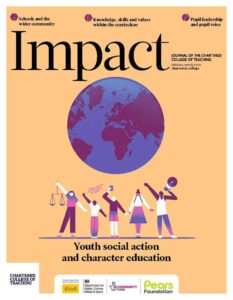Putting young people at the heart of cross-sector collaboration

Ndidi Okezie, CEO, UK Youth, UK
Let me jump straight in with a provocation. This is a reflection that has only recently crystallised for me, after almost 20 years of experience working in various areas of the UK education ecosystem.
There is a gaping disconnect between the formal education sector and the informal education sector. That disconnect does a great disservice to the children and young people we exist for.
During my time in teaching, I saw initiative after initiative come and go. New methods have their moment in the spotlight but the conversations that remain persistent are the ones around ‘capacity’ and the ‘opportunity cost’ of focusing on one priority over another. The conversations surrounding schools are often centred on the pedagogical choice for delivery, or the broader values and ethos of the school that determine the curriculum balance of ‘knowledge vs skills’ (see Strauss, 1984). Teacher workload remains an unresolved challenge. Much of my time at Pearson (Edexcel) was focused on how we could effectively reduce teacher workload and make the constantly growing, myriad things that teachers are expected to support young people through tenable. Not once during my time at Pearson (or, indeed, in my time before then) did we look beyond ‘the teacher’ and acknowledge the wealth of expertise that exists in other sectors. I am talking about the expertise that would help to achieve the wider goals that society has demanded schools be the ones to take sole responsibility for (see Smith, 2002).
Whether it is addressing critical life skills, difficulties at home, mental health challenges, serious violence or bullying, or simply managing the rollercoaster of emotions that comes with puberty, teachers are required to be all things to all pupils. They are charged with finding solutions to issues that ultimately show up in their classrooms and corridors – issues that another professional has invested time in training on and sharpening their effectiveness in, and yet never the twain shall meet. Disparate professionals with similar goals are busy going about their days, with their plans for supporting the same young people never strategically aligned.
Programmes run by youth organisations are often a direct response to a bespoke social or emotional challenge faced by the young people that they work with (NYA, 2020). Whether it is tackling gang culture, preparation for employability, positive mental health strategies or tackling online grooming, youth organisations have a distinctly unique lens into the lives of young people, and they tailor their development support accordingly. This isn’t to say that pastoral care in the school setting doesn’t attempt to provide nuanced support in this way (no one can tell me that I didn’t care about the ‘whole child’ when I was teaching them English). But it is a different skillset, deployed in an entirely different setting, and that distinction is important. And so, rather than trying to make one thing into another, why are we not drawing more on the skills that exist across both disciplines? Why are we not truly placing the needs of the child at the centre of their work?
Anecdotally, I’ve heard of examples where schools, youth, social and health services are really committed to working together, and yet they share how hard it is and how the systems across each setting seem to work against this collaboration.
An example of an ‘unintended benefit’ can be taken right from the evaluation of a programme that recently finished at UK Youth. EmpowHer wrapped up its latest cohort in August 2020. Funded by Spirit 2012 and #iwill, the programme uses social action to raise the confidence and overall wellbeing of young women and girls. Typically, as with many such programmes, the evaluation found that the ripple effect of positive impact on pupil performance was significant. This insight was discovered organically, because ‘school impact’ was not one of the research questions that had been requested for the evaluation.
The data showed how young people had linked what they gained from the programme to their life at school. One young girl commented:
‘Wow… a girl can achieve anything! I’ve never been taught about self-love at school but at EmpowHer, I learnt so much about that. EmpowHer really pushed me to want to achieve higher.’
Another young girl spoke about how she was engaging more at school as a direct result of her involvement with the EmpowHer programme. She said:
‘I’m still a bit shy but I’ve learnt how to communicate better through EmpowHer. In fact, I decided to join the school council; learning how to communicate in EmpowHer has helped me communicate in school meetings.’
The benefits of the EmpowHer programme lie in its ability to raise confidence, instil a sense of community and galvanise young people’s innate enthusiasm for doing good. However, there are of course clear benefits and links to be made to their academic education and progression. It’s not a question of should schools and youth organisations be working more strategically together; it’s a clear tragedy that they’re not. Even with the success of EmpowHer, we missed out on the chance to understand what the teacher was seeing on the other side of the programme. Imagine if the school were looped in right from the start and able to intentionally connect the learning, build on the insights and take the impact of the programme even further. Equally, youth workers have no insights into what else is going on at school – insights that they could draw upon to support young people. All sides are missing out on the chance to truly ensure that young people are surrounded by an effective network of support.
So, back to my opening provocation and to this challenge of disconnect that I have to say is currently consuming me: Why are the informal and formal education sectors so fragmented? We have become so accustomed to the stories of overworked teachers, resource-hungry youth clubs and young people left wanting. The inefficiencies of our current state should be igniting a movement of collaboration – and yet that isn’t happening. Why?
We have a teaching workforce that is on its knees, and my provocation is to suggest that perhaps all this time we’ve been looking for solutions in the wrong place. There is a need for all sectors to look up and look out. I joined the teaching profession before the ‘profession’ part was as well understood as it is now – before amazing places like the Chartered College existed. In my view, we are still on the journey of recognising that there are other ‘professionals’ that surround a pupil; professionals that have expertise that could be deployed before the challenge is so acute that the school has to step away. In a way that none of us would have ever imagined, COVID-19 has provided a burning platform for us to move more decisively into this area of cross-sector collaboration. The reality is that the challenges that our children and young people face are too great for any one sector to solve on its own. This is the time for us to bridge the youth divide and ensure that our strategies for support are intertwined and connected and truly place the needs of the young person at the locus of the endeavour.
References
National Youth Agency (NYA) (2020) Re-imagining schools: A youth work response to COVID 19. Available at: https://nya.org.uk/wp-content/uploads/2020/06/0888-NYA-COVID-19-SCHOOLS-report-P3.pdf (accessed 26 October 2020).
Smith MK (2002) Informal, non-formal and formal education: a brief overview of different approaches. The encyclopedia of pedagogy and informal education. Available at: https://infed.org/mobi/informal-non-formal-and-formal-education-a-brief-overview-of-some-different-approaches (accessed 26 October 2020).
Strauss C (1984) Beyond “Formal” versus “Informal” Education: Uses of Psychological Theory in Anthropological Research. Ethos 12(3): 195-222.










